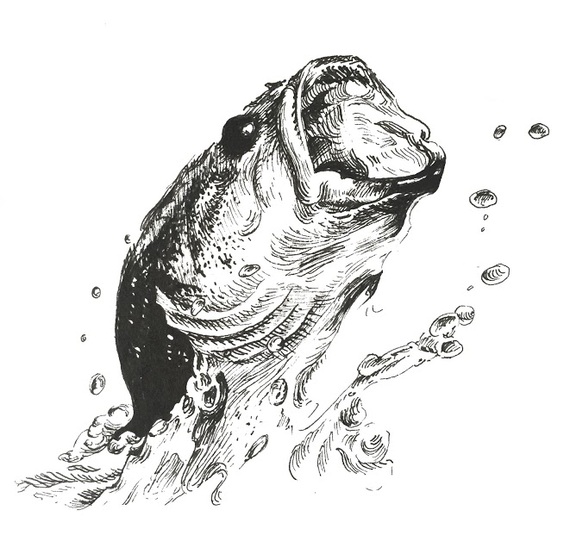
As a boy growing up in Santa Barbara, California, I used to fish for bass and sunfish in my neighborhood creek. During the summer when the creek was low, a deep pool formed a pond that I shared, begrudgingly, with other kids itching to fish. Over the course of the summer the pond coughed up fewer and fewer fish. The irony of my competing for this diminishing population of fish was that my neighbor who owned the creek-turned pond, Professor Garrett Hardin, would soon publish the world's most famous article on competition for a common resource.
Garrett Hardin's "The Tragedy of the Commons" appeared in the December 1968 issue of the prestigious journal Science. A Google Scholar search reveals that the publication has been cited over 27,000 times since its appearance in the literature almost half a century ago. Hardin used the example of herders exploiting the same pasture to graze their cattle to illustrate the inevitable collapse that befalls a common resource shared by individuals looking out for their own individual good. The basic tenet of The Tragedy of the Commons has been applied widely to models in economics, game theory, sociology, and ecology, among a variety of other topics and disciplines. Fishing, too, both recreational and commercial, is inherently well suited to Hardin's famous axiom.
The aquatic commons that harbor our world's fish, whether pond, lake, stream, river, bay or ocean, are largely subject to the same set of criteria that ensure sustainable recreational and commercial fisheries. Each commons must provide a healthy place for fish to live with adequate refuge from predators, for prey to consume and for appropriate habitat so species can reproduce. The water must be free of pollutants and excess sediments, and in the face of global climate change, not too warm, or in the case of our oceans, too acidified. If this is what a healthy commons needs, how do we avoid the tragedy?
Sustainable commons are free from poachers. This applies equally to fly fishers who take home more trout than permitted by law and to developed countries whose factory fleets are increasingly invading two-hundred nautical mile exclusive zones to deplete third-world countries of their fisheries. Coordinated management of a commons must happen, with fishers vying for limited fishing rights based on the unique life history of a given species and its rate of growth, age and size at reproductive maturity, and numbers of offspring. In addition, management of a commons is not possible without accurate reporting of catch data. Unfortunately, even today some developed countries routinely underreport their annual catch to the United Nations Food and Agricultural Organization (FAO) that oversees global fisheries.
Fisheries associated with various commons have long suffered from overfishing or environmental stressors. A century ago sturgeon was so abundant that fishermen complained about the fish slashing their nets; they tossed them out as by-catch. Later, the fish were harvested in vast quantities for their flesh and roe. Today, sturgeon are largely endangered, victim to both overfishing and the damming of rivers that reduces their spawning success. Atlantic cod have followed a similar fate, infamously overexploited in Newfoundland and then more recently, in the Bay of Maine. In the latter instance, both heavy fishing pressure and rapid climate warming have been implicated in the demise of the fishery. Antarctic toothfish have largely disappeared from regions of the Ross Sea, coincident with the onset of a recent fishery. Here, similar to the Patagonia toothfish, whose fate was largely sealed when renamed the more delectable "Chilean Seabass," slow growth and a long life span with late reproduction spelled trouble. Bluefin tuna have become so precious a commodity (in 2013 a single fish sold for 1.76 million dollars) that overexploitation is almost certain to doom the fishery.
Despite such challenges, hope for sustainable fisheries exists when commons are properly managed. The New Zealand blue cod fishery has licensed fishing rights and quotas set collectively by fishing companies and government fishery officials. Cod are taken by hook and line rather than bottom trawling or long-lining, two techniques destructive to habitat and to other species of fish. My favorite example of a sustainable fishery is not for fish, but rather Florida stone crabs. Stone crabs are harvested seasonally and only one claw above a certain size can be removed. Crabbers must then return the crab to the sea. Rapid regeneration of the claw results in a crab ready to make another donation the next year. Other sustainable fisheries include the meticulously managed Alaskan herring fishery and the hugely successful largemouth bass recreational fisheries that have spread around the globe. All of these fisheries share attributes of a sustainable commons: regulated and enforced fishing quotas and habitats with sufficient prey and largely free of environmental stress. With guidance from organizations such as the FAO, these practices can rejuvenate depleted fisheries; particularly in third world countries where fisheries are often small scale yet important to the local economy.
As my boyhood summers ended and early fall brought rain to Santa Barbara, the fishing pond reconnected to a flowing creek. The fresh creek water rejuvenated the pond, carrying away wastes and recharging the water with nutrients and oxygen. Aquatic insects were flushed into the pond from upstream, and a few large bass and sunfish moved in and spawned. Eventually, I made friends with the other neighborhood kids who fished the pond, and over time, we agreed to explore other fishing sites along the creek so we didn't fish out "Hardin's commons."
James McClintock is the Endowed University Professor of Polar and Marine Biology at the University of Alabama at Birmingham. His latest book, A Naturalist Goes Fishing - Casting in Fragile Waters from the Gulf of Mexico to New Zealand's South Island (St. Martins), was just released. Fish drawing - Annabelle Decamillis.